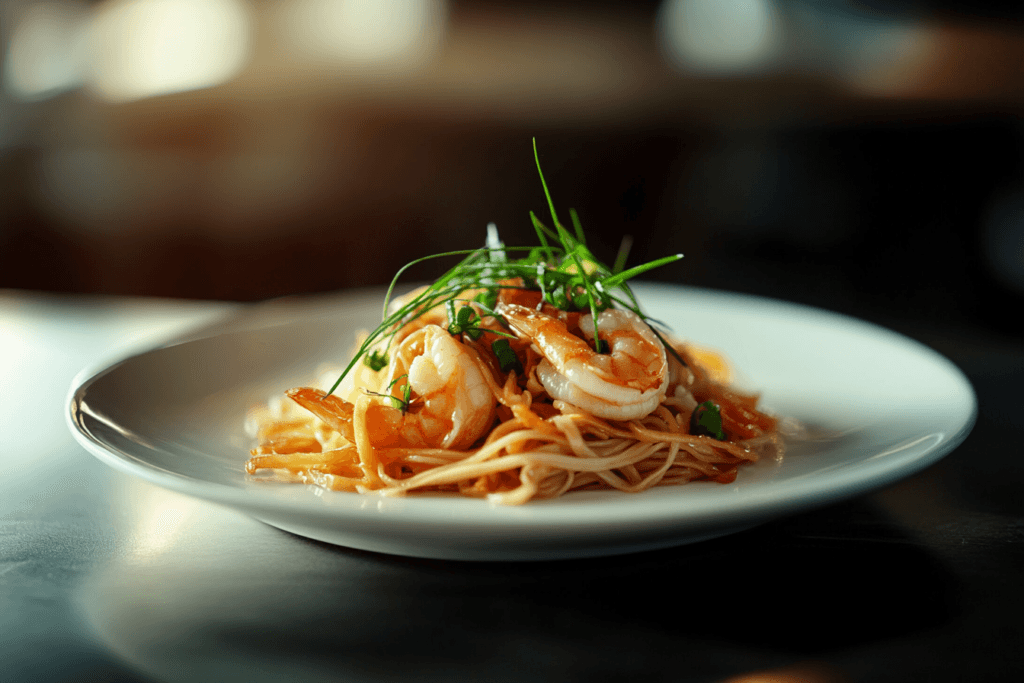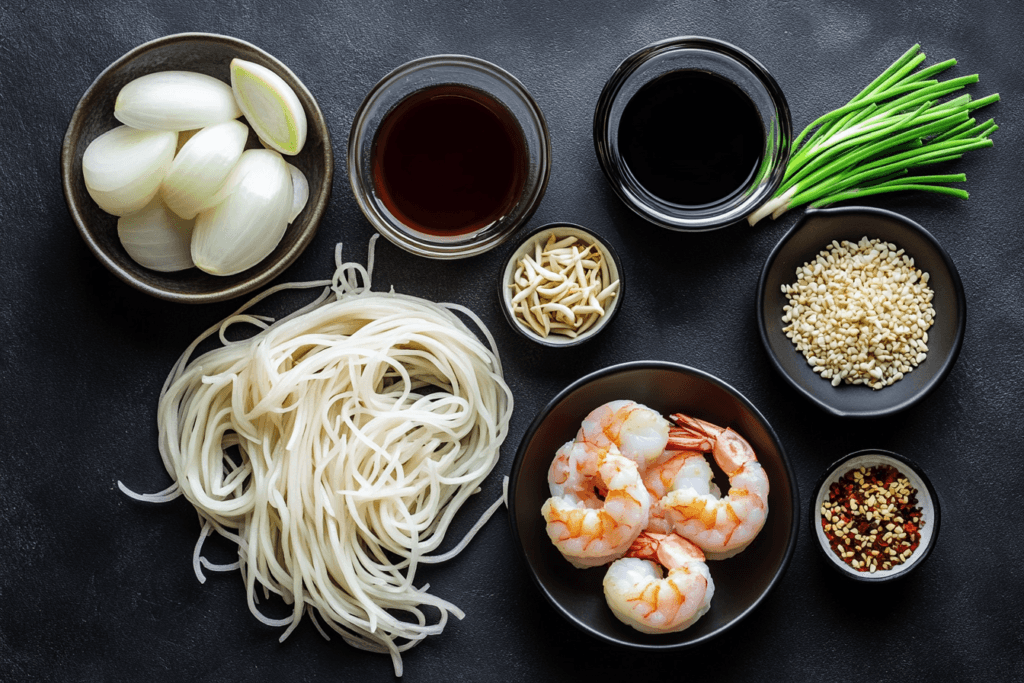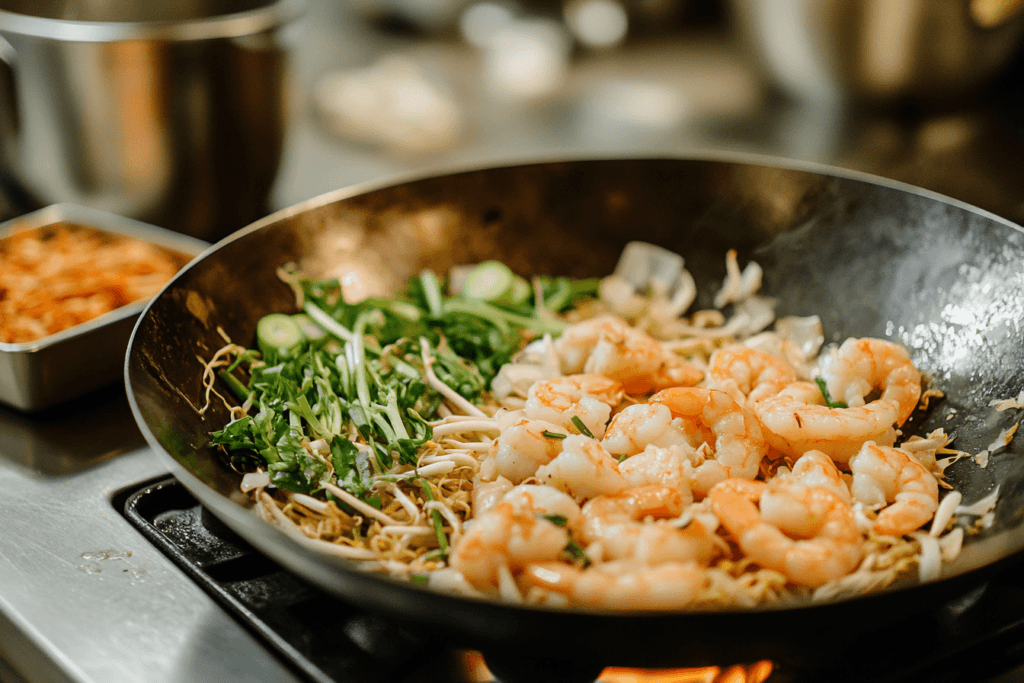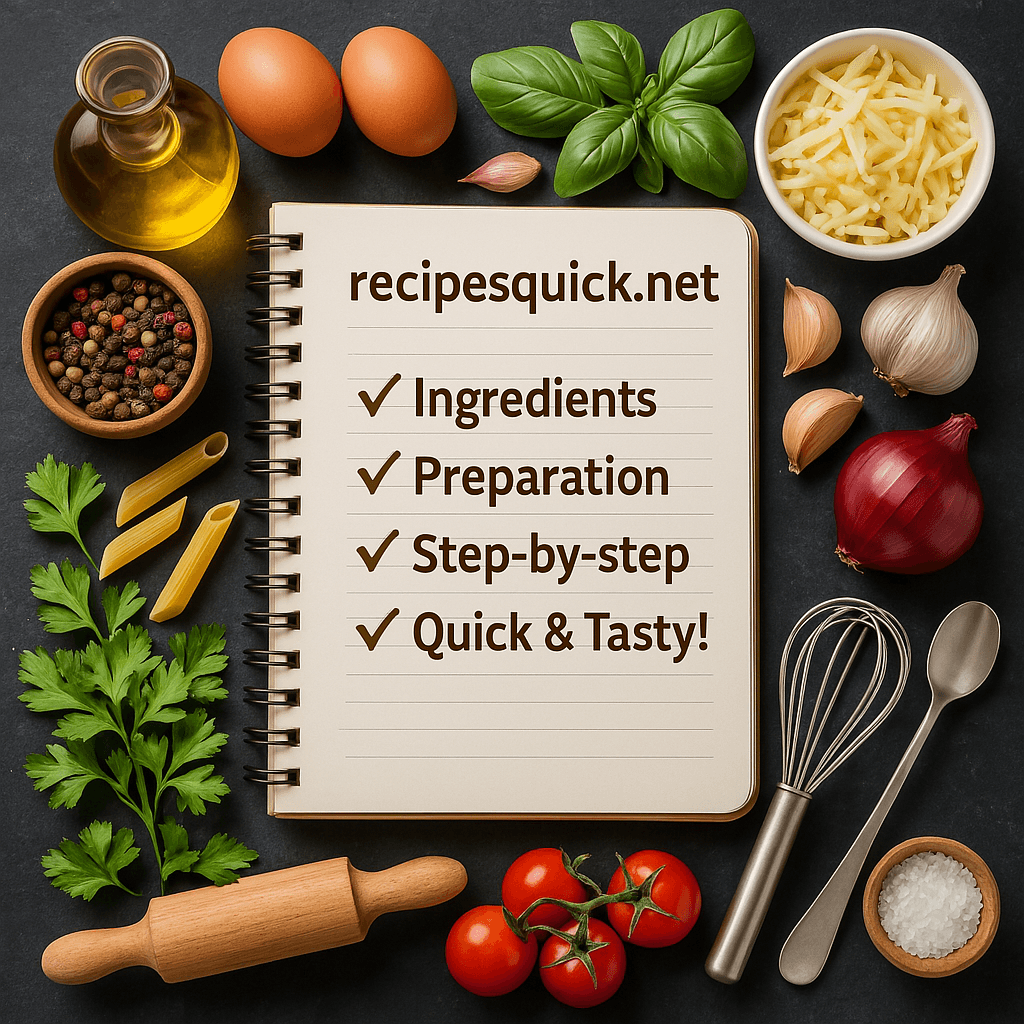The first time I tasted authentic shrimp chow mein, it was a game-changer. The crispy noodles, juicy shrimp, and fresh veggies made a simple meal into a feast. It’s more than just a dish; it’s a flavorful journey that brings Asian cooking to your home.
Imagine making a stir-fry as good as a restaurant’s, with big shrimp and crunchy veggies. Shrimp chow mein is a mix of textures and tastes that takes you to Canton’s lively streets.
Whether you’re an experienced cook or just starting out, this recipe will help you make a tasty meal. It’s easy to make and very satisfying.
Table of Contents
Understanding Authentic Chinese Chow Mein

Explore the world of authentic Chinese take-out with chow mein. This noodle stir-fry has won hearts around the globe. The name “ch’ao mien” means “stir-fried noodles” in Mandarin. It shows the dish’s humble yet tasty roots in Northern China.
When comparing chow mein vs lo mein, knowing the differences is key for noodle lovers. Here’s what makes them unique:
- Chow Mein Noodles: Thinner, dried egg noodles that are boiled and then fried to create a crispy texture
- Lo Mein Noodles: Thicker, fresh egg noodles that are fully cooked and mixed directly into the stir-fry
The main feature of authentic chow mein is its crispy noodles. American Chinese restaurants have made their own twist. They often fry the noodles into a crispy pancake, adding a crunchy bite.
| Characteristic | Chow Mein | Lo Mein |
|---|---|---|
| Noodle Type | Dried, thin egg noodles | Fresh, thick egg noodles |
| Cooking Method | Boiled, then fried | Fully cooked, mixed into stir-fry |
| Texture | Crispy | Soft |
Starting your journey into authentic Chinese cuisine means understanding these small but important differences. Next time you order chinese take-out, you’ll see the art of noodle stir-fry in a new light.
Essential Ingredients for Perfect Shrimp Chow Mein
To make a true seafood dish in Chinese cuisine, you need the right ingredients. Your shrimp noodles will be amazing with the perfect mix of fresh parts. These parts add flavor and texture to this classic stir-fry.
For the best shrimp chow mein, focus on a few key ingredients:
- Noodles: 330 g of egg noodles (chow mein noodles)
- Proteins: Fresh medium-sized shrimp
- Vegetables:
- 1 small yellow onion, thinly sliced
- Two handfuls of bean sprouts
- Two handfuls of garlic chives
The sauce is key to making your dish taste like authentic Chinese cuisine. Your sauce should have:
- 1 tablespoon regular soy sauce
- 1.5 tablespoons dark soy sauce
- 1 tablespoon oyster sauce
- 0.5 tablespoons sugar
- 0.5 teaspoons fish sauce
- 1 tablespoon water
Pro tip: Choose fresh shrimp for the best taste and texture. Look for shrimp that are firm, have a mild ocean smell, and look translucent with a slight shine.
When getting ready your ingredients, timing is everything. Most veggies like onions and bean sprouts cook fast – usually just 1 minute over high heat. This keeps them crisp and full of flavor.
Choosing the Right Noodles

Choosing the right noodles is key for a great shrimp noodle stir-fry. The noodles you pick can turn a simple meal into a masterpiece. It’s all about the noodles.
For the ultimate noodle stir-fry, you have many tasty options:
- Fresh Chow Mein Noodles: The gold standard for authentic flavor (recommended 10 oz or 280g)
- Hong Kong Pan-Fried Noodles: Crispy and delightful (recommended 8 oz or 225g)
- Dried Chow Mein Noodles: A convenient alternative (recommended 6 oz or 170g)
Fresh noodles are the favorite of true Chinese cuisine lovers. They offer a better texture and soak up flavors better than dried ones. But, if fresh noodles are hard to find, dried ones can still make a tasty shrimp noodles dish.
“The right noodle makes the difference between a good stir-fry and an extraordinary one.” – Chinese Culinary Experts
Here are some tips for cooking noodles perfectly:
• Rinse fresh noodles in cold water before cooking
• Cook dried noodles al dente to prevent mushiness
• Pat noodles dry to ensure a crisp stir-fry texture
Remember, the noodles you choose affect the dish’s taste and authenticity. Spend time picking the best noodles, and your shrimp chow mein will be amazing!
Selecting and Preparing the Shrimp
Choosing the right shrimp is key for a tasty shrimp chow mein. Opt for medium-sized shrimp (31 to 40 per pound). They should be fresh and smell like the ocean.
Here’s how to prepare your stir-fried shrimp:
- Inspect shrimp for freshness
- Clean and devein thoroughly
- Pat dry with paper towels
- Prepare a flavor-enhancing marinade
Creating a great marinade is essential for your shrimp chow mein. Mix these ingredients for maximum flavor:
| Ingredient | Quantity |
|---|---|
| Soy Sauce | 2 teaspoons |
| Rice vinegar or apple cider vinegar mixed with a little sugar | 1 tablespoon |
| Cornstarch | 1 teaspoon |
| White Pepper | 1/4 teaspoon |
Marinate your shrimp for 10-15 minutes before cooking. This makes them tender and flavorful. Shrimp cook fast, so watch them closely to avoid overcooking.
Pro tip: Always buy shell-on shrimp when possible, as they tend to be fresher and more flavorful for your stir-fried shrimp dishes.
The Secret to the Perfect Stir-Fry Sauce
Making the ultimate stir-fry sauce is key to any Chinese dish. Your shrimp chow mein recipe needs a mix of flavors to turn simple ingredients into a top-notch meal.
The base of a great stir-fry sauce for your shrimp chow mein includes several important ingredients:
- Oyster sauce – Provides deep umami flavor
- Low-sodium soy sauce – Adds saltiness
- Shaoxing wine – Brings complexity
- Sesame oil – Introduces nutty undertones
- White pepper – Delivers subtle heat
When making your stir-fry, remember these sauce amounts:
- ½ cup low-sodium soy sauce
- 1 tablespoon toasted sesame oil
- ¼ cup brown sugar or honey
- 2 teaspoons freshly grated ginger
- 2 tablespoons cornstarch for thickening
The secret to a perfect sauce is balancing sweet, salty, and umami flavors. Whisking these ingredients creates a harmonious blend that will make your shrimp chow mein amazing.
Pro tip: Let your sauce simmer for about 5 minutes after adding cornstarch. This makes the sauce rich and glossy, coating your noodles and shrimp beautifully.
Fresh Vegetables for Your Stir-Fry
To make a great noodle stir-fry, pick the right veggies. They should make your shrimp chow mein taste like it’s from a restaurant. Choose fresh, crisp veggies that match the shrimp’s flavor and add color and texture.
Here are the top veggies for your stir-fry:
- Napa Cabbage: It’s mild, sweet, and crunchy
- Carrots: They add bright color and a bit of sweetness
- Bell Peppers: They bring vibrant colors and a crisp feel
- Bean Sprouts: They add a fresh, crunchy touch
Want to try something new? Here are some alternatives:
- Bok Choy: It’s tender, nutritious, and green
- Snow Peas: They’re delicate, crisp, and sweet
- Green Onions: They add a mild, sharp taste
When prepping veggies for your shrimp chow mein, slice them evenly. Then, stir-fry them quickly for 2-3 minutes. This keeps them crisp-tender and full of flavor. By picking and preparing your veggies well, you’ll make a stir-fry that’s as good as any Chinese take-out.

Essential Cooking Equipment and Techniques
To make a real stir-fry, you need the right tools and skills. Start with a top-notch wok or big skillet. A 12-inch pan is best for tossing ingredients and getting the right texture.
Choosing the right gear is crucial for your shrimp chow mein. Here’s what you’ll need:
- Carbon steel wok or large non-stick skillet
- Long-handled wooden spatula or wok turner
- High-heat resistant cooking oil (peanut or vegetable oil)
- Sharp chef’s knife for precise ingredient preparation
Mastering high-heat cooking is key to a great stir-fry. Wok hei, or the “breath of the wok,” is about quick, intense heat. It caramelizes ingredients and adds a smoky flavor.
“Stir-frying is an art of speed and precision – every second counts!” – Professional Chinese Chef
Remember these techniques for your noodle stir-fry:
- Prepare all ingredients before heating the pan
- Use high heat consistently
- Keep ingredients moving constantly
- Cook in small batches to maintain temperature
With the right tools and techniques, your home cooking will shine like a pro’s. You’ll master Chinese cuisine in no time.
Step-by-Step Cooking Process
Making the perfect shrimp chow mein recipe needs precision and skill. Follow these steps to turn simple ingredients into a dish that tastes like it came from a restaurant.
Begin by getting your ingredients ready. For the stir-fried shrimp, use medium-sized ones (31-40 per pound). Make sure your chow mein noodles are in blocks for the best texture.
- Boil the noodles for about two minutes until they’re just tender
- Drain and set aside the noodles
- Heat your wok with oil and get ready to crisp the noodles
- Fry noodles for 2-3 minutes until they’re golden brown on the bottom
- Flip and keep frying for another three minutes
When cooking the shrimp, time is key. Cook them quickly – about 1-2 minutes per side until they’re pink and opaque. Take them out and set them aside to avoid overcooking.
“The secret to great stir-fry is high heat and quick cooking” – Professional Chef
Stir-fry your vegetables fast to keep them crisp. Most veggies only need 2-3 minutes to be perfectly tender-crisp.
| Ingredient | Quantity | Cooking Time |
|---|---|---|
| Shrimp | 1 pound | 1-2 minutes per side |
| Noodles | 10-12 ounces | 2-3 minutes frying |
| Vegetables | Mixed assortment | 2-3 minutes |
Mix your crispy noodles, cooked shrimp, and colorful veggies with your sauce. Toss everything in the hot wok. Make sure each ingredient is coated and heated evenly.
Common Cooking Mistakes to Avoid
Mastering shrimp chow mein means avoiding key cooking mistakes. These errors can ruin your dish. Knowing these common mistakes helps you make a tasty, authentic meal.
Heat control is vital when cooking shrimp chow mein. Low heat can make veggies soggy and flavor weak. Your wok or skillet should be blazing hot for the right stir-fry texture.
- Overcooking shrimp: Prawns should be cooked for only 3 minutes until they turn pink
- Using insufficient heat during stir-frying
- Adding too much sauce, which can make the dish soggy
- Overcrowding the cooking pan
- Not preparing ingredients in advance
Getting noodles right is also key. Overcooking noodles makes them mushy, ruining the dish. Always cook noodles as directed and rinse them with cold water to stop cooking.
The secret to great shrimp chow mein is balancing ingredients. Use about 200 grams of raw prawns and measure sauces carefully. A good marinade includes 2 tablespoons of light soy sauce, 1 tablespoon of sesame oil, and 1 tablespoon of rice wine.
Pro tip: Prep all ingredients before you start cooking to ensure a smooth stir-frying process.
Storage and Leftover Tips
Your tasty shrimp noodle dish can last longer than one meal. With the right storage, you can enjoy it for days.
Keeping your shrimp chow mein fresh is key. Here are some tips to help:
- Cool the dish completely before storing (15-20 minutes)
- Use an airtight container for refrigeration
- Store in the refrigerator for 3-4 days maximum
When reheating, be careful to keep the dish’s texture and taste. The best ways to do this are:
- Microwave: Reheat in 30-second increments
- Skillet: Stir-fry for 3 minutes with a little oil
- Ensure internal temperature reaches 140°F
Pro tip: The noodles might soften slightly after storage, but the flavors will remain delicious!
| Storage Method | Duration | Recommended Reheating |
|---|---|---|
| Refrigerator | 3-4 days | Microwave or Skillet |
| Room Temperature | 2 hours max | Not recommended |
By following these tips, you can enjoy your homemade shrimp noodle dish longer. And you’ll waste less food.
You’ve unlocked the secrets of making an amazing shrimp chow mein. This dish turns your kitchen into a gourmet spot. It’s ready in just 30 minutes and serves 3-4 people, with only 354 calories per serving.
This shrimp chow mein is super versatile. You can change the protein, add different veggies, or adjust the spice. Mastering this recipe opens up a world of authentic Chinese cooking in your kitchen.
Cooking is an adventure. Every time you make this stir-fry, you’ll get better. It’s perfect for family meals or impressing friends. Your homemade shrimp chow mein will be a hit, proving you don’t need takeout for great food.
Now, use your new cooking skills to explore Asian cooking. Your shrimp chow mein journey is just the start of many tasty adventures.
Craving more mouthwatering, fast, and effortless recipes? 🍽️✨ Unlock a world of irresistible flavors at recipesquick.net and transform every meal into a delight!


